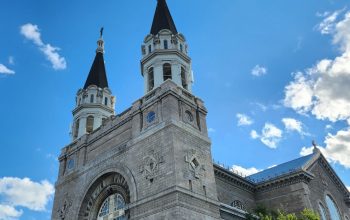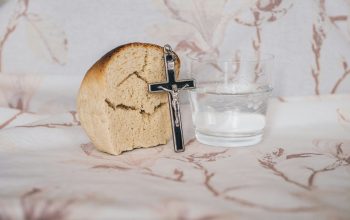Photo Credit: Wikipedia
How the Light of Christmas can help us sort through darkness in our daily lives
Marcella van Run, The Mike Copy Editor
In a moment of inspired goofiness, I wrote a sonnet for my best friend. I wrote about a drove of leaves swirling across a field beneath an autumn sunset. One leaf drifts from the rest to the ground below, where it stirs a second leaf already fallen upon the field. Together, they lift off again and continue swirling in dance toward the setting sun.
My best friend likes fields. I like poems. We both like the fall season and sunshine and dancing. My sonnet, silly as it was in its conception, turned out to be a happy composite of these little things that colour our time together.
We have the same goal, and we stir one another to it every day. It’s a goal that feels like it can be chased forever, like the sun, sometimes sinking and sometimes shining, but always lighting our world; sometimes using the moon, sometimes with the blinding blaze of full day, and sometimes cutting darkness with dawn. The goal is the Light and the Light is a brightness and an armour and it can reach the ends of the earth.
Christmas is creeping around the corner. November snow has already smothered fall leaves in winter slush and disappeared just as fast. Advent candles will soon flicker and melt, and twinkling lights will adorn our trees and frame our porches. The night will be flecked with little lights; with far-off stars and bulbs on drooping strings. But just as autumn leaves are buried and candle wax melts, the pretty show of Christmas lights will end when they all come down, when the storefronts stow away their smiling Santas to usher in Valentine’s Day. “So Eden sank to grief, / So dawn goes down to day,” writes Robert Frost in his poem, “Nothing Gold Can Stay.” But our Light is not a passing craze.
“Unfailing light has penetrated everywhere, and sunset has turned into dawn,” wrote St. Clement of Alexandria in his Exhortation to the Greeks. My sonnet ends with the leaves in an “eternal sunset dance” — but that’s not how things work. Seasons change and people change and days change when the sun sets and then rises again. “Todo se pasa, Dios no se muda,” are lines from St. Teresa of Avila’s famous poem, “Nada Te Turbe.” “All things pass, God does not change.” The sun sets and the dawn breaks and it is a new day, but the same God.
We won’t be in an eternal sunset dance because the sun will rise, but what’s more: we may not even make it to the dawn. The 22nd chapter of The Imitation of Christ by Thomas à Kempis gives fair warning: “In the morning consider that you may not live till evening, and when evening comes do not dare to promise yourself the dawn.” There is still something ethereal yet eternal about a sunset glow. Gerard Manly Hopkins in God’s Grandeur exclaims at “morning, at the brown brink eastward;” at that brownish ruddy rising of the sun “though the last lights off the black West went” — even though it has just set. The sunset glow murmurs that somewhere there is an Unfailing Light: One whose source is not the sun. “No longer will your sun set or your moon wane; for the Lord will be your light forever” (Isaiah 60:20).
Forever is a big promise, and in a world where promises can be delicate and shatter often, it might seem daunting. It can be difficult to know where to begin in the constellation of eternity. Stars look brighter when we see them in the open air, from fields outside on cloudless nights — but even through foliage or city smog, they twinkle where we cannot see. The promise is real, even when darkness floods our vision. The goal remains distinct because it is everlasting. There was one star that hovered above something truly unchanging: a child, present from the beginning, yet only just coming into the world (John 1:9). There was one star that led three Wise Men to real Light.
I always come back to this image from Flannery O’Connor’s Wise Blood:
“Jesus moved from tree to tree in the back of [Hazel’s] mind, a wild ragged figure motioning him to turn around and come off into the dark where he might be walking on the water and not know it and then suddenly know it and drown.”
Stars blink, the sun sets, leaves fall — and we catch Jesus in glimpses, beckoning to us from unexpected places: a manger, the water, in the midst of joy and sadness. The call is terrifying. We are accustomed to feeling silly and fearing that we might misunderstand something and then drown because we thought we were on solid ground. Words can be slippery, like ice, and trust can be hard. Turning around and moving forward can be a trudge through a blizzard of uncertainty. Realizing not that “this is water,” but rather Who is calling us out upon it: that is at the heart of the matter. Our goal is the hand from above that reaches down to hoist us up; it is marked by the star above the manger and announced by choirs of angels. The Word to be trusted is found in John’s Gospel: “He who follows Me, walks not in darkness” (John 8:12).
There’s a forest of trees, and there’s the slippery ice, and there’s the dark water, and there’s a creeping sensation that in the obscurity of mixed metaphor — the trees and the ice and the dark and the water and Jesus darting somewhere between them — there is a knowledge that drowns. What if? What if the ragged figure is not Him? What if it is, and what does that mean for me? What if the promise is really for ever and ever, in saecula saeculorum, for eternity?
These aren’t necessarily the questions that plunge us into darkness. As students, Advent coincides with crunch time; exams and due dates pile up around us like unpleasant presents. There is a pressure to be knowledgeable; to know what people are thinking; to know what we are going to do with the rest of our lives; to know what we are going to do tomorrow. These can be questions that dim the light and bring on anxieties about who we are and what we are made for, if we are made at all. We lose sight of the path that does not stray. We trip and we fall and we look up and can no longer see the forest for the trees — let alone the man between them; the child wrapped in swaddling clothes. We can no longer see that while we are born in a double darkness of sin and ignorance, His Light and Wisdom can penetrate any gloom.
At Christmas, missing Christ between the pines and presents can be an ironic oversight. There’s talk of taking Christ out of Christmas (not an entirely new concept if the likes of King Herod are concerned). Trying to blot the memory of Christ out of shiny tinsel and string lights is one thing — but there is no removing Him from Christmas. Unfailing Light will not be torn down for storage when the seasons change; “the light shines in the darkness, and the darkness has not overcome it” (John 1:5). Likewise, His light will not go out when you need it most. Not in sadness, not in suffocating surges of schoolwork, and certainly not in situations more dire. You can catch glimpses of His constant pursuit of you when you stop and look and remember. It is up to you to decide when His pursuit will be enough; when you let into your heart the promise of unfailing light.
Mary held that promise in her arms. He fulfilled every prophecy; every angelic message. When the Light came into the world on Christmas Day — when the sun set on the Holy Family in Bethlehem that night — the transient and the transcendent met in mystery. There were no fireworks or glittering confetti or explosive streamers, but there was true and lasting joy. There was a mother and her child: the daybreak from on high, the light of the human race, the beginning and the end (Luke 2:78, John 1:5, Rev 21:6).
“The Best is Yet to Come” was scrawled in a pretty gold font on the card my best friend gave me for my birthday. This sunset, glowing gold or brown on the horizon, or sinking far off and impossible to discern, is only one sunset. Today is only today; it is not even this week, or this month, this year, undergrad, education, career, family, life — the best is yet to come. Let yourself feel the anticipation at His promise; let joy mount and swell in your heart as Advent winds down and we remember the birth of Christ. “The true light, which enlightens everyone, was coming into the world” (John 1:9). And He came into the world. And He promised that He would come again. With every gift you give or receive this Christmas, every moment of joy and laughter and love, know that it is only a foretaste of His plan for you.
And if you don’t have those moments, know that there is still joy, because Christmas happened. When dawn breaks, when the leaves fall, when Christmas lights go up and even when they come down — His promise shines forth. A sunset is so beautiful because it is never really a goodbye, but rather a goodnight — we will meet again, brighter and more brilliant, together in a world to come. This is not a trick of the light.
“Lead, Kindly Light, amid the encircling gloom,
Lead Thou me on!
The night is dark, and I am far from home —
Lead Thou me on!
Keep Thou my feet; I do not ask to see
The distant scene, — one step enough for me.”
St. John Henry Newman, “The Pillar of the Cloud”




